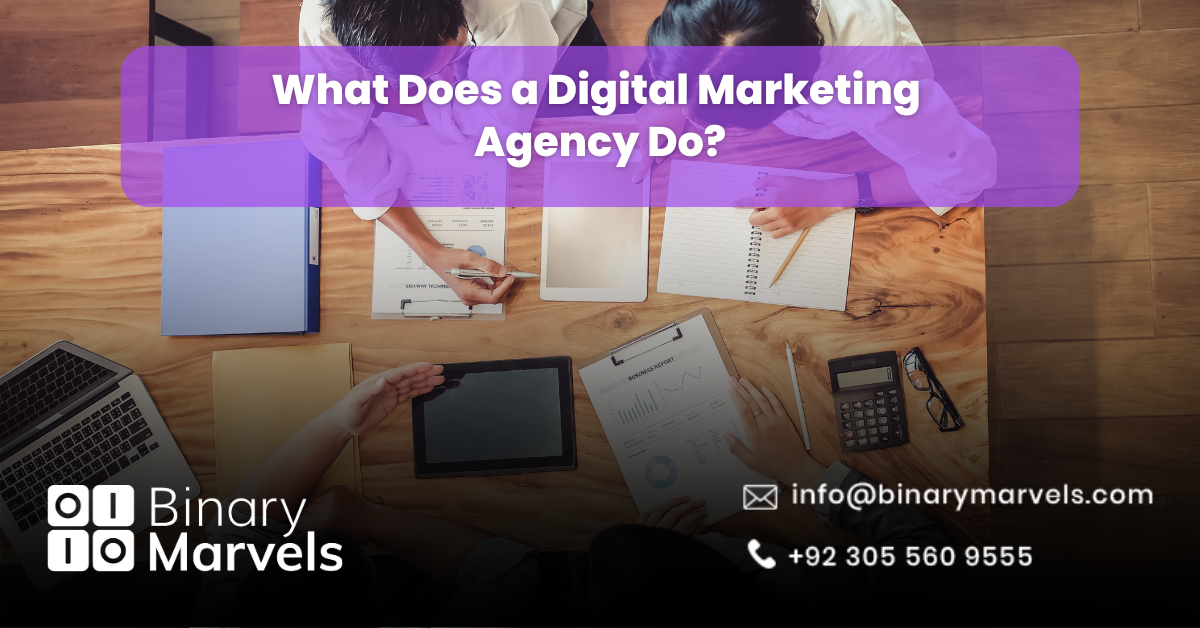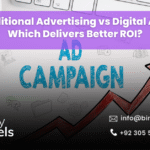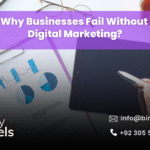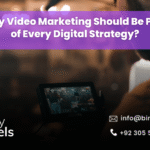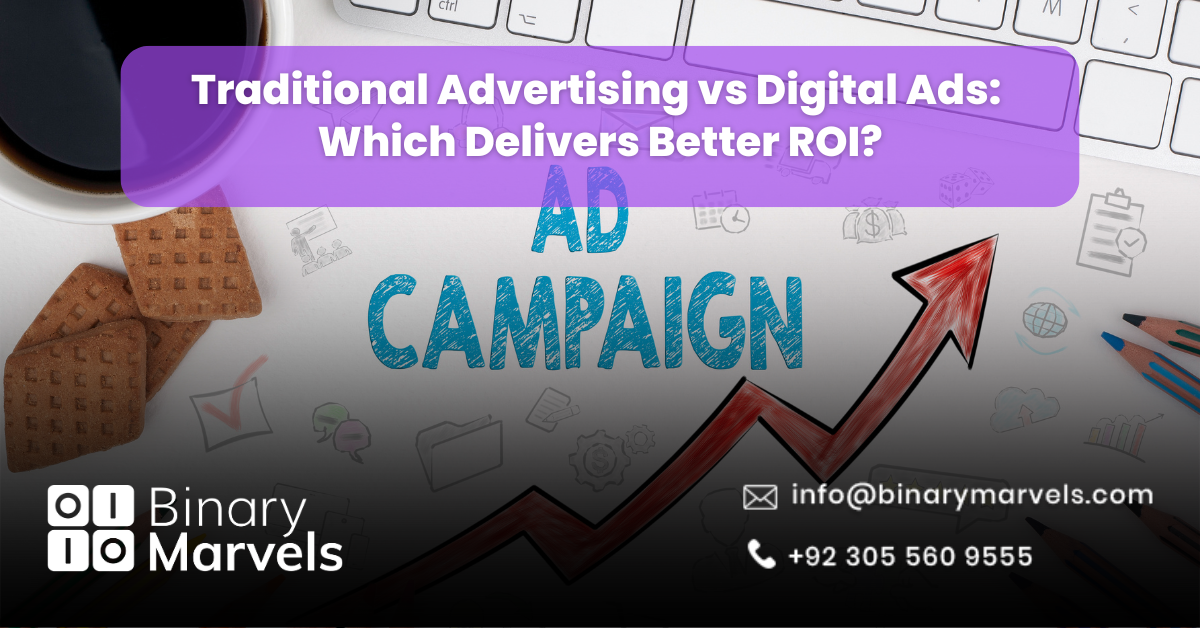
Are you wondering whether traditional advertising or digital ads deliver better ROI for your business? In a world where marketing budgets need to generate measurable results, choosing the right platform can make all the difference. Traditional advertising methods like TV, radio, and print have long been trusted for their wide reach and brand-building power. However, digital advertising has transformed how businesses connect with customers, offering real-time data, precise targeting, and flexible budgets.
Even established brands and growing companies like a leading software house are shifting their focus toward data-driven strategies that offer tangible returns. Let’s explore how traditional advertising compares with digital ads and discover which approach can truly maximize your ROI.
Understanding Traditional Advertising
Traditional advertising refers to the classic methods of promoting products or services through offline channels such as television, radio, newspapers, magazines, and billboards. For decades, these platforms have been the backbone of brand awareness campaigns, helping businesses reach large audiences and build trust.
One of the major advantages of traditional advertising is its ability to create strong emotional connections through storytelling and visual appeal. A well-placed TV commercial or a striking billboard can leave a lasting impression and reinforce brand recognition over time.
However, traditional advertising comes with limitations. It’s often expensive, difficult to measure accurately, and lacks precise audience targeting. Unlike digital ads, you can’t track how many people viewed your billboard or converted after seeing a newspaper ad. This lack of real-time performance data makes it challenging to calculate ROI effectively.
Still, for local businesses and companies targeting broader audiences, traditional advertising can play a valuable role in complementing modern marketing efforts.
Also Read: SEO vs PPC: Which Digital Marketing Strategy Delivers Better ROI?
What Are Digital Ads and How Do They Work?
Digital ads refer to online promotional campaigns that appear across platforms like search engines, social media, websites, mobile apps, and video streaming services. They allow businesses to reach specific audiences based on demographics, interests, behavior, and location. Unlike traditional ads, digital campaigns are data-driven, measurable, and easy to optimize in real time.
Through tools like Google Ads, Facebook Ads, and Instagram promotions, businesses can create targeted campaigns that focus on conversions rather than just visibility. The biggest advantage is control—you can set your budget, monitor engagement, and adjust strategies instantly for better performance.
With the help of professional digital marketing services, brands can create well-structured campaigns, track detailed analytics, and maximize ROI. These services ensure that every click, impression, and conversion contributes to measurable growth, making digital advertising one of the most cost-effective ways to reach potential customers today.
Comparing ROI: Traditional vs Digital Advertising
When it comes to measuring ROI, the gap between traditional and digital advertising becomes clear. Traditional advertising, while effective for brand exposure, often lacks measurable results. It’s difficult to determine how many customers saw your TV commercial or took action after reading a print ad. The cost of production and placement can also be high, reducing overall returns.
Digital advertising, on the other hand, offers precise tracking through analytics tools. Marketers can measure impressions, clicks, conversions, and engagement in real time. This allows for smarter budget allocation and campaign adjustments that directly impact ROI.
Here’s a quick comparison of how both approaches perform:
| Aspect | Traditional Advertising | Digital Advertising |
|---|---|---|
| Cost Efficiency | High production and placement costs | Flexible budgets with measurable results |
| Targeting | Broad, often non-specific audiences | Highly targeted based on demographics and interests |
| Tracking ROI | Difficult to measure accurately | Real-time performance tracking |
| Engagement | One-way communication | Two-way engagement through comments, clicks, and shares |
| Flexibility | Limited once campaign is live | Easily adjustable anytime |
While traditional ads can still help with brand recall, digital ads clearly outperform them in terms of efficiency, adaptability, and return on investment.
Factors Influencing ROI in Advertising
Whether you invest in traditional or digital advertising, several key factors determine how effectively your campaigns deliver returns. Understanding these elements can help you make better marketing decisions and achieve a stronger ROI.
1. Audience Targeting
Knowing your audience is the foundation of every successful campaign. Digital ads allow detailed targeting based on location, interests, and behaviors, while traditional ads often rely on broader audience segments.
2. Campaign Strategy
A well-defined strategy that aligns with business goals ensures your ad spend is used effectively. This includes choosing the right platforms, crafting engaging messages, and setting measurable objectives.
3. Creativity and Messaging
Compelling visuals and persuasive copy are crucial. In both advertising types, creativity determines how well your message captures attention and drives action.
4. Budget Allocation
Smart budgeting can significantly improve ROI. With digital ads, you can test small campaigns, analyze performance, and scale what works—something not easily achievable with traditional ads.
5. Conversion Tracking and Analytics
Data plays a vital role in understanding performance. Digital platforms provide instant feedback, helping marketers optimize campaigns in real time for better results.
When these factors work together, your advertising—whether traditional or digital—can generate measurable and long-lasting returns for your brand.
Also Read: How to Choose the Best Social Media Channels for Your Business?
Why Businesses Are Shifting Towards Digital Marketing?
In today’s competitive market, businesses are rapidly transitioning from traditional advertising to digital platforms. The reason is simple: digital marketing offers better control, real-time results, and higher ROI. Unlike traditional ads that rely on broad exposure, digital campaigns are targeted, measurable, and cost-effective.
One major advantage of digital marketing is the ability to analyze performance instantly. Businesses can track which campaigns drive traffic, generate leads, or increase sales. This transparency allows marketers to optimize strategies on the go and allocate budgets to what actually works.
Another driving factor is consumer behavior. With more people spending time online, digital ads reach customers where they are most active—on social media, search engines, and mobile devices. This ensures better engagement and brand visibility.
Partnering with a professional digital marketing agency can further enhance results. Experts can design tailored strategies, manage ad performance, and continuously improve ROI through data-driven insights. It’s no surprise that modern businesses, regardless of size, are embracing digital marketing as the smarter and more profitable choice.
Is There Still a Place for Traditional Advertising?
While digital marketing dominates today’s landscape, traditional advertising still holds value in certain contexts. Methods like TV, radio, and print can create strong emotional connections and brand credibility, especially for audiences who prefer offline media. For instance, a powerful television commercial or a well-placed magazine ad can make a lasting impression that builds long-term brand recognition.
Traditional advertising also works well for local exposure and mass outreach. Events, billboards, and flyers can effectively reach audiences who may not be as active online. For brands targeting multiple age groups or aiming to establish a solid presence within a specific region, traditional methods can complement digital efforts beautifully.
The most successful brands often use a hybrid approach, combining traditional and digital advertising to achieve both reach and precision. By integrating both methods, businesses can build brand awareness through traditional media while driving conversions and tracking performance through digital channels. This balance ensures a complete, results-driven marketing strategy that maximizes ROI from every angle.
Supercharge Your Business with Digital Marketing Today!
As a trusted Digital Marketing Agency in Rawalpindi, we deliver result-driven digital marketing services designed to boost your online presence, generate leads, and grow your business.
Don’t wait, connect with us now and take your brand to the next level!
Conclusion: Which One Delivers Better ROI?
When comparing traditional advertising with digital ads, the difference in ROI often comes down to measurability and adaptability. Traditional advertising excels at building brand trust and awareness, but it struggles to track conversions or customer actions. Digital advertising, on the other hand, allows you to see exactly how your campaigns perform, where your audience engages, and what drives results.
For most businesses today, digital ads deliver better ROI due to their flexibility, cost efficiency, and data-driven approach. They allow constant testing, real-time adjustments, and precise audience targeting that simply isn’t possible with traditional media.
However, that doesn’t mean traditional advertising is obsolete. The most effective strategy often blends both—using traditional methods to establish credibility and digital platforms to convert engagement into measurable growth.
If you want to improve your marketing performance and see real results, consider exploring professional digital marketing services tailored to your business goals. With the right strategy, you can maximize your reach, strengthen your brand, and achieve a higher ROI across every campaign.

